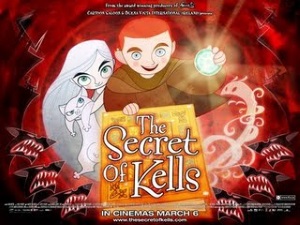
Working through the lengthy list of animated films that my wife wants to watch, we arrive at this French-Belgian-Irish production. It was nominated for Best Animated Feature at the 2010 Oscars but lost out to Up. I’d be the first to complain that the Academy Awards are unfairly biased in favored of American productions. For example in 2007 Persepolis lost to Ratatouille and in 2010 The Illusionist lost to Toy Story 3, both questionable decisions. But in this case, I have to say that the Academy was probably right.
The protagonist here is Brendan, a young boy who have lived his entire life behind the walls of the abbey of Kells in Ireland. The land is menaced by Viking raiders and the abbot Cellach, who is also Brendan’s uncle, is obsessed with building a wall to keep them out. But the boy and indeed most of the other monks seem more interested in illuminating beautiful manuscripts. The story really gets going when a famous illuminator Aidan arrives at the abbey, bringing with him a great but incomplete book started by a saint. No prizes for guessing whose destiny it is to finally complete this work.
The thing to note here is that many of these are references to Irish mythology and the history of the Catholic Church in Ireland, though being the philistine that I am, I recognized none of them while watching. For example, the Book of Kells exists and is apparently considered the national treasure of Ireland. Both Aidan and Columba are real church figures. Crom Cruach is naturally a pagan god and even Pangur Bán is apparently a cat featured in a famous poem. It’s clear that those who do get all these references will get much more of a kick out of it.
All this is told using a visually unique art style so stylized as to verge on the abstract. Its flat and two-dimensional, yet intricately detailed style is clearly inspired by the illustrations that appear in the Book of Kells and similar works. One particularly impressive scene is when Brendan finally confronts Crom Cruach and the monster is depicted as a giant serpent composed of straight lines and fractals. The contrast between that and the rounded, organic shapes of the characters we’re supposed to consider as the good guys is blunt perhaps but it works.
Unfortunately however much I like how this is inspired by Irish mythology and how beautiful the art is, I have to give a thumbs down on this one because it gets pretty much everything else wrong. A full list of my complaints would be too long to write out: why does the abbey appear to be the primary defense against the Viking raiders, how the characters are all so stereotypical and therefore uninteresting, why does Aisling seek to help Brendan, since when is the position of an abbey abbot a hereditary position that can be left to a nephew and so forth. But really all of these problems with the story boil down to single root cause: to tie things together and have them make sense this film needs to be about the Christian faith but it lacks the courage to put it at its center where it belongs. Instead it tries to be safe and uses Christianity only as a theme while playing everything off as a fantasy.
This is why the film fails to convince us of the importance of Brendan’s and Aidan’s efforts to complete the book. If it were merely a work of art, then however beautiful it is, the abbot must surely be right that their efforts should be focused towards surviving against the raiders, even if his idea of relying solely on defensive walls is wrong. But it’s not just a work of art. It is about spreading Christianity as far and as wide as possible and believing that Christ brings salvation, it is about having the courage to be a Christian even if it kills you to do so, and yes it is about fighting against pagan beliefs in an age when they were still dominant. But this film is so scared of all this that it doesn’t even say what is in the Book of Kells or even once mention Jesus. It is in fact the four canonical gospels that make up the New Testament.
Recently the Hugo Awards were embroiled in a controversy whereby a clique of conservative writers hijacked the nomination process. One of the key people involved is fundamentalist Christian writer Theodore Beale. Out of curiosity, I recently read a novelette of his that was nominated for the Hugos in 2014. I mention this because the subject of the story is about a person who sacrifices everything, including decades of his life, to illuminate a manuscript and in the process finds faith in God. Now I don’t recommend that anyone read it. I find the prose overly florid, the premise pretentious and the writer’s politics hateful. But I do like to point out that he at least gets why illuminating a religious text is an act of devotion and successfully conveys to the reader its significance. This is much more than anything that the directors of The Secret of Kells have done.
Of course, I am fully aware of why this is so. The Secret of Kells is at heart a children’s cartoon and doesn’t aspire to be any more than that. That’s also why this isn’t a film that deserves to be taken seriously. It’s great that it wants to bring attention to Irish culture and the treasure that is the Book of Kells but it is also frankly insulting that it doesn’t even dare to say that it is the Bible.
One thought on “The Secret of Kells (2009)”